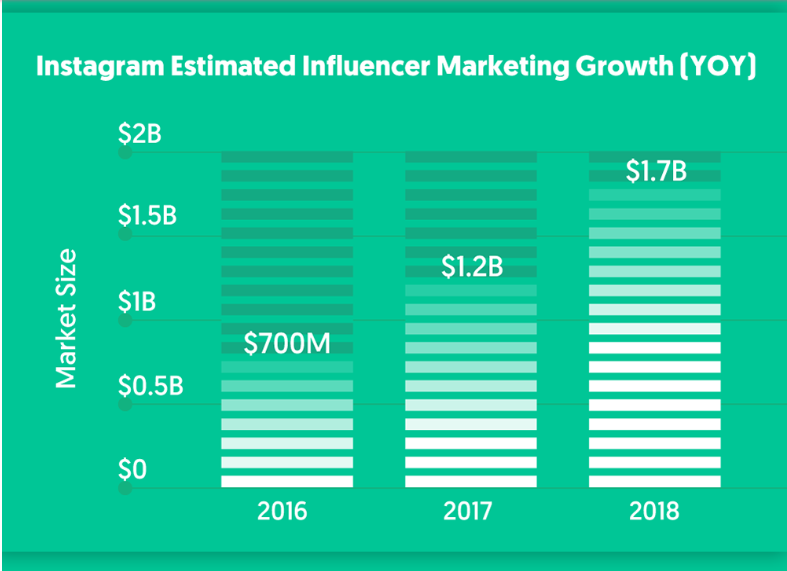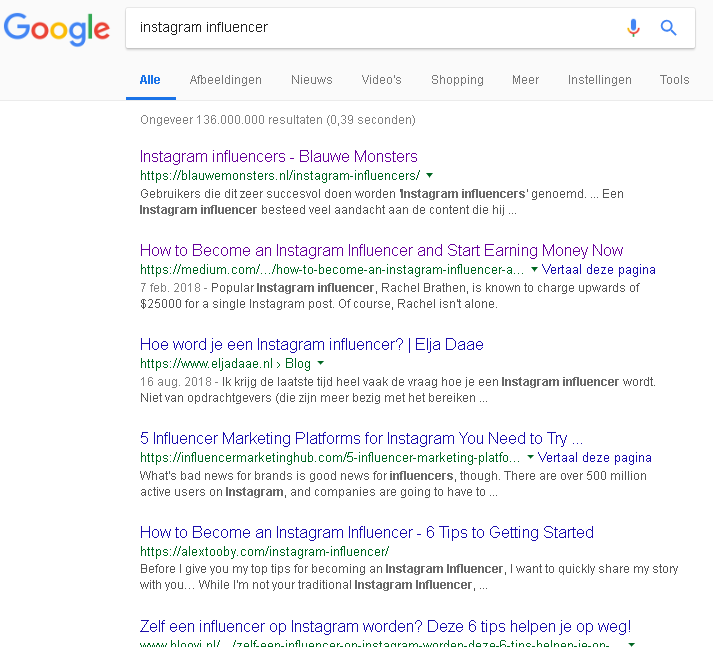
I’m an Instagram Influencer, what do you do for a living?
Our globalized network society and Instagram in particular has changed the ways we think about work. As a result, new professions have developed. One example of this is the Instagram Influencer, which has quickly grown into a large business.
Nowadays more than half of the world is using the internet and almost 3.2 billion of those users are on at least one social media platform. From January 2017 to January 2018 there has been an increase of 13% in social media users around the world. The time spent on social media is growing as well. In the Netherlands, for example, people on average spend up to 1,5 hours on social media every day. (Kemp, 2018)
We are doing things we never did before.
This tremendous, ongoing growth of the internet and social media use over the years has made it possible to exchange information and knowledge with people from around the world. This has caused a shift in the world from being a production economy to an information and knowledge economy in which we are always connected. This is what characterizes the current stage of globalization. A stage in which our society can best be defined as a network society (Castells, 1996).
The network society we live in and the technological affordances it comes with have all sorts of social, behavioral, and structural effects. One of those effects is a change in the way we view work around the world and subsequently the jobs we have. We are doing things we never did before.
Introducing the Instagram influencer
An important part of globalization is social media. That’s why the rise of social media platforms directly stimulates change, new concepts, and new ideas. One of these new concepts is the Instagram influencer.
Influencers are “individuals who have a significant impact on a social media platform. Brands partner with these influencers to promote their product or service.” The Instagram influencer originates from ‘commercial lifestyle blogging’: (mostly) women who blog about their lifestyle through various social media platforms.
Once a so-called lifestyle blogger becomes a micro-celebrity due to appearances in digital and print media and due to various physical and digital endeavors, one can be called an influencer. An influencer should at least have a large following, present their ‘real life’ and lifestyle through social media, engage with their followers, and earn money by making guest appearances at important events and doing advertorials (highly personalized advertisements). Instagram is the main platform for influencers because pictures are the most viable way to advertise products.
If you search for ‘influencer’ on Google, dozens of webpages appear telling you how to become a successful influencer.
Figure 1: Instagram estimated influencer marketing growth

Figure 1: Instagram estimated influencer marketing growth
Influencers are taking over social media platforms like Instagram. In the last two years there has been a growth of 17,4 million (from 6,8 to 24,2 million) in brand sponsored influencer posts and the market size has gone from 700 million dollars to 1,7 billion dollars (Fig. 1).
With 800 million Instagram users (September 2011) it is not remarkable that the Instagram influencer business is expanding so quickly. Because of this major popularity of the Instagram influencer, a lot of people are attracted by this idea and look at it themselves. If you search for ‘influencer’ on Google, dozens of webpages appear telling you how to become a successful influencer (Fig. 2).
Figure 2: Searching for 'Instagram influencer' on Google
Of course, it is very difficult to become a macro- or celebrity influencer like Kim Kardashian who earns up to 500.000 dollars per post (Fig. 3). But even a micro-influencer can earn some money on Instagram. The reward is lower (around 100 dollars per post) but easily earned.
Figure 3: Kim Kardashian promoting lipgloss

Figure 3: Kim Kardashian promoting lip gloss
The Instagram influencer makes a living through sharing their lifestyle within different networks. Our current society is based on networks and the exchanging of knowledge and information through these networks. In this article the connection between our network society and the way we view work around the world, will be further explored.
Important effects of technological developments
As mentioned before, the development of new technologies has different structural, social, and behavioral effects. An important behavioral effect is the detachment of communication and information from a certain fixed place. To obtain information or communicate there is no need to go to a library or meet face-to-face. This creates a situation where people are always online consuming but also producing information('prosumers').
An important social effect is the emergence of new forms of online on platforms like Facebook or Instagram. But also more focused communities within larger communities, like the #HealthInfluencers stream on Instagram. These social and behavioral effects create structural effects, as for example the rise of a network society (Castells, 1996).
What is a network society?
What makes our current society different from earlier societies is not necessarily that it is centered around information and knowledge; this was also partly true in the past. ‘Networking’ is what makes our society new and different. In the past, networking was a term used for the private sphere. Larger domains in the world such as war and the economy (production) were controlled by large vertical organizations like churches and armies. With the rise of new technologies, networks were able to expand to a size never seen before (Castells, 1996).
In our current society, communication exceeds borders and can thus create large global networks and connections between those networks.
A network society is “a social structure based on networks operated by information and communication technologies based in microelectronics and digital computer networks that generate, process, and distribute information based on the knowledge accumulated in the nodes of the networks” (Castells & Cardoso, 2005). In other words, it is about the social structure of our society. And that social structure exists of different networks that are powered by microelectronic communication- and information technologies.
Nowadays, with the upcoming of new technologies a normal worker needs to be highly skilled, computerized, flexible, a part of the global network, and possess a lot of soft skills.
Two important aspects of the network society are Power and Exclusion/Inclusion. Being successful within the network society all comes down to being in- or excluded. The rules for being in- or excluded differ for all networks. In the past it used to be harder to be included in networks because they were hard to access.
Nowadays it is easier to become a part of a network, especially online networks, due to technological developments. The chance of being excluded from a network is therefore lower. Although it can be easier to access a network, the power you obtain within that network still depends on how much you offer to the network (Castells, 1996). Power is a person’s ability to impose their will over someone else’s. In a network society this is best done by controlling or influencing the communication process.
The network society has a lot of effects on the world, one of those effects is a new profile of a ‘normal worker’. In the old days a normal worker was someone who got their hands dirty. Nowadays, with the upcoming of new technologies a normal worker needs to be highly skilled, computerized, flexible, a part of the global network and possess a lot of soft skills (Vallas & Christin, 2018).
The evolution of work
In the 19th century, work became a commodity. It was viewed as a process that needed to be as efficient as possible. To make it as efficient as possible, workers were exploited to a maximum. They got paid very badly, had to work many hours in bad circumstances and without any protection or benefits.
In the 20th century work became increasingly de-commodified in large parts of the world. Workers got more regulated workings hours, regulated pay, safe working conditions, job security, and protection in the form of a pension and illness provisions. In other words, the exploitation of workers was drastically reduced.
Basically, this is still the case, but this reality has has is under fierce pressure. Although it seems that in an increasing amount of organizations a re-commodification of work is taking place. For example, working hours are now often de-regulated. In a lot of organizations, people are expected to work overtime and answer e-mails in the evenings and on Sundays.
Also, job security is becoming more relative. Even though technically a worker still has rights and cannot be fired without good reason, it is becoming easier to find irrational reasons to fire someone. Organizations can, for example, have a socio-ideological focus on labor control. They not only judge a worker on the work that is delivered, but also on their soft skills, such as their personality, creativity, motivation, and attitude. A worker can be fired based on not being motivated enough (Alvesson & Willmott, 2002). This creates an overlap between the private self and the work self.
People need to create a ‘personal brand’ when trying to get a job: not only advertising your qualities needed for executing a function, but also your soft skills, who you are as a person and why that fits a job.
With the rise of new technologies and social media platforms this is encouraged even more. It is expected to make yourself visible online. Many people perceive this as a natural part of today’s modern economy (Vallas & Christin, 2018).
Introducing Instagram influencer Steph Claire Smith
Personal branding, gaining power, networking, and soft skills are becoming of more importance in obtaining a job or being judged suitable within a job. Important soft skills are motivation, authenticity, and trustworthiness (Rebelo, 2017).
The Instagram influencer is embracing these soft skills. Trustworthiness and authenticity, for example, are of utmost importance to promote products. Another element of the network society that the Instagram influencer embraces is the networking and combining of networks.
Figure 3: Steph Claire Smith promoting bondisands

Figure 4: Steph Claire Smith promoting bondisands
A great example of an Instagram influencer who embraces all assets of our network society and the way we view work in this society is Steph Claire Smith. At the outset the influencer is promoting a certain lifestyle, a certain view at the world. This is the primary reason influencers obtain their following. The advertising of products can be accepted by their following if it is presented in an authentic, trustworthy manner, fitting their image and lifestyle. Steph Claire Smith does so by partnering with certain brands fitting her image and making sure the products she advertises are a part of her healthy, body conscious lifestyle (Fig. 4).
In 2013, 11,5% of US companies made use of Instagram for their marketing purposes. In 2017 this number had already increased to an astonishing 70,7%
Another way Smith embraces the network society is by enlarging her own network and interconnecting networks she is a part of. She is making herself the link between different communities, she is connecting different worlds.
At the start, her main network was the fitness and health world. Over the years, she has broadened her horizons to a variety of networks connecting them through her and her personal brand. Steph Claire Smith is the brand that promotes sunglasses, a book, a health app, clothing lines, healthy food, and all kinds of products like tan lotion and facial cremes. (Fig. 5). Besides that, she is also active in the modelling world.
Figure 4: Steph Claire Smith promoting her book

Figure 5: Steph Claire Smith promoting her book
The work Steph Claire Smith does is also gaining more and more recognition in the sales world. In 2013 11,5% of US companies made use of Instagram for their marketing purposes. In 2017 this number had already increased to an astonishing 70,7%. There is also a rise in platforms to connect influencers and brands and a growth in companies offering ‘influencer services’ which leads to a lot of new job opportunities. These new jobs fit the image of identities becoming increasingly important in being successful (Collinson, 2003). Also, a job is a lot more than a place you go to from 9 to 5. It can be a lifestyle and it can be very global.
How we view work in a network society
This Instagram influencer presents a lot of features of our current network society. In our network society, certain aspects of work have gained importance. For example: soft skills, personal branding, and networking. These aspects are not only important to obtain a job, but also to grow professionally. It is already visible in all sorts of jobs: people need to create a personal brand and network to be successful. The Instagram influencer has taken this to a whole new level by earning money by solely doing that: branding their personality, making one persona out of the private self and the work self.
Nowadays, we perceive this as ‘normal’. There are even companies offering influencers for advertising, or websites on how to become an influencer.
In other words, the network society has completely changed the way we view work and has made us do things we never did before.
References
Abidin, C. (2016). Aren’t these just young, rich women doing vain things online? Influencer selfies as subversive frivolity. Social Media + Society 2(2), 1-17.
Alvesson, M., & Willmott, H. (2002). Identity regulation as organizational control: Producing the appropriate individual. Journal of management studies, 39(5), 619-644.
Castells, M. (1996). The Rise of the Network Society. The Information Age: Economy, Society, and Culture Volume I (Information Age Series). London: Blackwell.
Castells, M., & Cardoso, G. (2006). The network society: From knowledge to policy. Washington, DC: Johns Hopkins Center for Transatlantic Relations.
Kemp, S. (2018). Digital in 2018: World’s internet users pass the 4 billion mark.
Collinson, D. L. (2003). Identities and insecurities: Selves at work. Organization, 10(3), 527-547.
Influencer Marketing Hub. (n.d.a). 15 Mind Blowing Instagram Statistics You Don't Know.
Influencer Marketing Hub. (n.d.b). The Remarkable Rise of Influencer Marketing [Infographic].
Vallas, S. P., & Christin, A. (2018). Work and identity in an era of precarious employment: How workers respond to “personal branding” discourse. Work and Occupations, 45(1), 3-37.
Ward, T. (2017, June 26). This Is The Future Of Influencer Marketing [Article]. Forbes.
Rebelo, M. F. (2017). How influencers’ credibility on Instagram is perceived by consumers and its impact on purchase intention (Doctoral dissertation).
